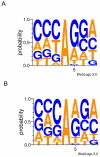Analysis of TP53 mutation spectra reveals the fingerprint of the potent environmental carcinogen, aristolochic acid
- PMID: 23422071
- PMCID: PMC3689860
- DOI: 10.1016/j.mrrev.2013.02.003
Analysis of TP53 mutation spectra reveals the fingerprint of the potent environmental carcinogen, aristolochic acid
Abstract
Genetic alterations in cancer tissues may reflect the mutational fingerprint of environmental carcinogens. Here we review the pieces of evidence that support the role of aristolochic acid (AA) in inducing a mutational fingerprint in the tumor suppressor gene TP53 in urothelial carcinomas of the upper urinary tract (UUT). Exposure to AA, a nitrophenathrene carboxylic acid present in certain herbal remedies and in flour prepared from wheat grain contaminated with seeds of Aristolochia clematitis, has been linked to chronic nephropathy and UUT. TP53 mutations in UUT of individuals exposed to AA reveal a unique pattern of mutations characterized by A to T transversions on the non-transcribed strand, which cluster at hotspots rarely mutated in other cancers. This unusual pattern, originally discovered in UUTs from two different populations, one in Taiwan, and one in the Balkans, has been reproduced experimentally by treating mouse cells that harbor human TP53 sequences with AA. The convergence of molecular epidemiological and experimental data establishes a clear causal association between exposure to the human carcinogen AA and UUT. Despite bans on the sale of herbs containing AA, their use continues, raising global public health concern and an urgent need to identify populations at risk.
Keywords: 7-(deoxyadenosin-N(6)-yl)aristolactam; AA; AA-UUT; AL-DNA adducts; AL-dA; Aristolochic acid(s); BEN; Balkan endemic nephropathy; COSMIC; Catalogue of Somatic Mutations in Cancer; HUF; Herbal remedies; Hotspot mutations; Hupki embryonic fibroblasts; IARC; IARC DB; IARC TP53 Database; ICGC; International Agency for Research on Cancer; International Cancer Genome Consortium; LOF; Nephropathy; TP53; TP53 mutation; Trp53; UUT; UUT tumors from patient cohorts with documented or suspected exposure to AA; UUT tumors from patient cohorts with no known or suspected exposure to AA; Urothelial cancer; aristolactam-DNA adducts; loss of wild-type function; nonAA-UUT; the human p53 tumor suppressor gene; the mouse p53 tumor suppressor gene; upper urinary tract tumors.
Copyright © 2013 Elsevier B.V. All rights reserved.
Figures





Similar articles
-
Aristolactam-DNA adducts are a biomarker of environmental exposure to aristolochic acid.Kidney Int. 2012 Mar;81(6):559-67. doi: 10.1038/ki.2011.371. Epub 2011 Nov 9. Kidney Int. 2012. PMID: 22071594 Free PMC article.
-
p53 mutations as fingerprints for aristolochic acid: an environmental carcinogen in endemic (Balkan) nephropathy.Mutat Res. 2009 Apr 26;663(1-2):1-6. doi: 10.1016/j.mrfmmm.2009.01.005. Epub 2009 Feb 4. Mutat Res. 2009. PMID: 19428366 Free PMC article. Review.
-
Exceptionally long-term persistence of DNA adducts formed by carcinogenic aristolochic acid I in renal tissue from patients with aristolochic acid nephropathy.Int J Cancer. 2014 Jul 15;135(2):502-7. doi: 10.1002/ijc.28681. Int J Cancer. 2014. PMID: 24921086
-
Aristolochic acid-induced upper tract urothelial carcinoma in Taiwan: clinical characteristics and outcomes.Int J Cancer. 2013 Jul;133(1):14-20. doi: 10.1002/ijc.28013. Epub 2013 Feb 12. Int J Cancer. 2013. PMID: 23292929
-
Aristolochic acid nephropathy: Harbinger of a global iatrogenic disease.Environ Mol Mutagen. 2013 Jan;54(1):1-7. doi: 10.1002/em.21756. Epub 2012 Dec 13. Environ Mol Mutagen. 2013. PMID: 23238808 Review.
Cited by
-
Unveiling correlations between aristolochic acids and liver cancer: spatiotemporal heterogeneity phenomenon.Chin Med. 2024 Sep 28;19(1):132. doi: 10.1186/s13020-024-01003-y. Chin Med. 2024. PMID: 39342223 Free PMC article. Review.
-
Bioactivation mechanisms of N-hydroxyaristolactams: Nitroreduction metabolites of aristolochic acids.Environ Mol Mutagen. 2019 Dec;60(9):792-806. doi: 10.1002/em.22321. Epub 2019 Aug 16. Environ Mol Mutagen. 2019. PMID: 31374128 Free PMC article.
-
Acute and Subchronic Toxicity Studies of Aristolochic Acid A in Tianfu Broilers.Animals (Basel). 2021 May 27;11(6):1556. doi: 10.3390/ani11061556. Animals (Basel). 2021. PMID: 34071750 Free PMC article.
-
Genomic approaches to DNA repair and mutagenesis.DNA Repair (Amst). 2015 Dec;36:146-155. doi: 10.1016/j.dnarep.2015.09.018. Epub 2015 Sep 15. DNA Repair (Amst). 2015. PMID: 26411877 Free PMC article. Review.
-
Aristolochic acid-associated cancers: a public health risk in need of global action.Nat Rev Cancer. 2022 Oct;22(10):576-591. doi: 10.1038/s41568-022-00494-x. Epub 2022 Jul 19. Nat Rev Cancer. 2022. PMID: 35854147 Review.
References
-
- Vogelstein B, Kinzler KW. Carcinogens leave fingerprints. Nature. 1992;355:209–210. - PubMed
-
- Hollstein M, Sidransky D, Vogelstein B, Harris CC. p53 mutations in human cancers. Science. 1991;253:49–53. - PubMed
-
- Giglia-Mari G, Sarasin A. TP53 mutations in human skin cancers. Hum. Mutat. 2003;21:217–228. - PubMed
-
- Pfeifer GP, Denissenko MF, Olivier M, Tretyakova N, Hecht SS, Hainaut P. Tobacco smoke carcinogens, DNA damage and p53 mutations in smoking- associated cancers. Oncogene. 2002;21:7435–7451. - PubMed
-
- Pfeifer GP, Hainaut P. On the origin of G --> T transversions in lung cancer. Mutat. Res. 2003;526:39–43. - PubMed
Publication types
MeSH terms
Substances
Grants and funding
LinkOut - more resources
Full Text Sources
Other Literature Sources
Research Materials
Miscellaneous

